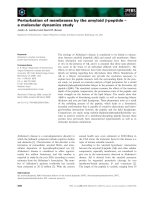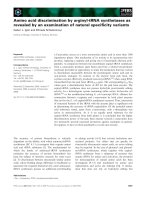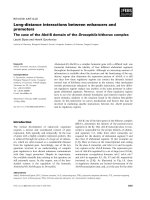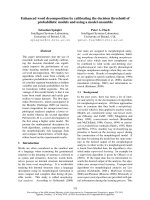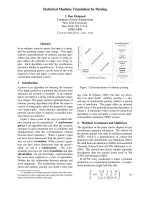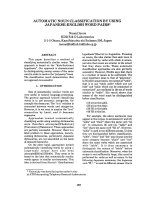Báo cáo khoa học: "Long Sentence Analysis by Domain-Specific Pattern Grammar" pptx
Bạn đang xem bản rút gọn của tài liệu. Xem và tải ngay bản đầy đủ của tài liệu tại đây (95.92 KB, 1 trang )
Long Sentence Analysis by Domain-Specific Pattern Grammar
Shinichi Doi, Kazunori Muraki, Shinichiro Kamei & Kiyoshi Yamabana
NEC Corp. C&C Information Technology Research Laboratories
4-1-1, Miyazaki, Miyamae-ku, Kawasaki 216, JAPAN
1
Long Sentence Analysis
We propose a method for analyzing long complex
and compound sentences that utilizes global struc-
ture analysis with domain-specific pattern grammar.
Previously, long sentence analysis with global in-
formation used the following methods: two-level
analysis global structure analysis of long sentences
with domain-independent function words and pars-
ing of their constituents[Doi
et al.,
1991], and pat-
tern matching adaptation of domain-specific fixed
pattern to input sentences. By utilizing domain-
dependent information the latter method could an-
alyze long sentences of that domain. But since
the
matching is made only on the surface the sentence
isn't analyzed well when patterns appear recursively.
2
Domain-Specific Pattern Grammar
Our method analyzes the global structure of long
sentences by using three knowledge-bases: domain-
specific patterns that can be described as a phrase
structure grammar, a list of keywords that denote
constituents of the patterns, and a pure basic gram-
mar. An input sentence is initially parsed and di-
vided into its constituents with these knowledge-
bases, and then each constituent is parsed with a
general grammar. Each constituent must be guaran-
teed uniformity by parsing with pure basic grammar.
To obtain a pattern grammar of Japanese long
sentences we analyzed the structures of about 750
long sentences from the leads of news articles in a
Japanese newspaper, Asahi Shinbun, and identified
several fixed global patterns. An example of pat-
tern grammar is shown in Fig. 1. Using the pattern
grammar and keyword list(a-c), the global structure
of the sentence(d) was analyzed as f).
3 Conclusion
Our method takes advantage of both two-level anal-
ysis and pattern matching, and can deal with the
irregular appearance of patterns including recursive
patterns, ellipsis of constituents and patterns that
appear in only part of the sentence.
We have developed a Japanese lead analyzing sys-
tem using a pattern grammar. We used this sys-
tem with several 80-200 word Japanese leads such as
the example sentence in Fig. 1., and obtained correct
global structures and syntactic trees for them.
References
[Doi et
al.,
1991] Shinichi Doi, Kazunori Muraki,
and Shinichiro Kamei. Lexical Discourse Gram-
mar and its Application for Decision of Global De-
pendency (II). In
Proceedings WGNLC of the IE-
ICE,
NLC91-29(PRU91-64), 1991. (in Japanese)
Fig. 1 ExRmple of Pattern Grammar and Keywords in Japanese
a) pattern grammar (p. denotes
phrase)
statement report pattern
:~ subject p. + date p. + situation p. + theme p. + direct statement p. + indirect statement p.
b) keyword list for a) (see e))
c) pure basic grRmmar noun p. ::~ adnominal p. + noun p., verb p. ::~ adverbial p. + verb p.
d) example sentence of Japanese lead
Nakasone-shushou-wa 17-nichi,
shuuin-honkaigi-de okonawareta kakutou-daihyou-shitsumon-deno touben-de,
Kokka-himitsu-houan-nitsuite "kokueki-wo mamoru-tame-nimo nanrakano datouna sochi-ga hitsuyou"-to
nobe, jimintou-giin-niyoru houan-sai-teishutsu-ni maemuki-no shisei-wo shimeshita.
e) keywords in d)
(mk. pp.
denotes
marking postposition)
-wa(subject mk. pp.) / 17-nichi(day), / touben(answer)-de(location mk. pp.), / -nitsuite(theme mk. pp.)
/ -to(quotation ink. pp.) nobe(said), / shisei(attitude)-wo(object mk. pp.) shirneshita(showed).
f) global structure of d)
subject p. : Nakasone-shushou-wa (Prime Minister Nakasone)
date p. :
17-nichi,
(on 17th.)
situation p. :
shuuin-honkaigi-de okonawareta kakutou-daihyou-shitsumon-deno touben-de,
(in the answer
to the party leaders' interpellations at the plenary session of the House of Representatives)
theme p. : Kokka-hirnitsu-houan-nitsuite (about the National-Secret-Bill)
direct : "kokueki-wo
mamoru-tame-nimo nanrakano datouna sochi-ga hitsuyou"-to nobe,
statement p. (said "some appropriate measures are needed to defend the national interest")
indirect
: jimintou-giin-niyoru houan-sai-teishutsu-ni maemuki-no shisei-wo shimashita.
statement p. (showed a positive attitude toward re-introducing of the bill by the Liberal Democrats)
466


